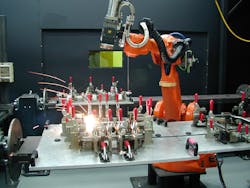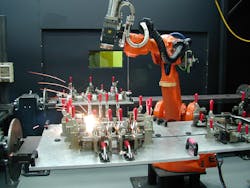Remote fiber laser welding, brazing, and cutting
Shelby Township, MI - Tony Pinho, president of Duggan Manufacturing, says, “Custom, precision metal parts manufacturers like ourselves must utilize, and be familiar with, the most advanced manufacturing technologies. For example, we recently undertook a major investment in remote fiber laser processing equipment and hired Vancho Naumovski, one of the leading experts in the application of remote fiber lasers for welding. Mr. Naumovski has spent over 20 years in laser processing, he has been a co-author on a number of patents in the laser field, and will serve as Duggan Manufacturing’s new director of laser technology. With his assistance we were able to design and build our first remote laser welding system in just six weeks.”
Naumovski explains, “What we have established here at Duggan Manufacturing is a unique new flexible laser welding system, delivered through fiber optics that significantly reduces weld time on complicated and non-complicated parts. We have demonstrated production improvements of up to 50% by combining robots within the system. The new process development facility includes a manufacturing cell anchored with an ABB robot and equipped with two Precitec welding heads, a 5 kW IPG fiber laser, two rotary fixtures, and two trunnion fixtures. This cell configuration allows us to process a wide variety of two- and three-dimensional parts as well as cylindrical part designs. Initial prototype parts that we are currently targeting are those where remote laser welding technology has already been proven. These include automotive and truck seating components and assemblies, automotive muffler assemblies, instrument panels, body-in-white assemblies, battery cells and solar cell array assemblies,” (see photo).
Fiber laser, mounted to robot, is shown placing 22 welds in 13 seconds on automotive seating components.
Naumovski adds, “High-powered remote fiber laser welding, brazing, and cutting has been an advanced manufacturing technology that has grown rapidly over the past five years because of its proven increase in weld processing speeds, reduction in consumables such as weld wire and cover gas, requires less tooling and part fixturing, and substantially reduces the on-going maintenance costs typically associated with conventional welding processes. In addition, related to product design, remote laser welding offers 1) the ability to design the product to access all weld locations from one side. 2) The ability to have flange sizes reduced, ultimately benefiting weight reduction. 3) The ability to produce a faster/better quality weld. 4) the ability to improve product geometries through higher power densities permitting less heat input within the weld joint, directly reducing heat deformation within the assembly. 5) The ability to weld at speeds above two times faster than either MIG or spot welding. Typically, spot-welding robots take two to three seconds to generate each weld. A laser can generate two or three welds per second.”
“In a typical remote laser welding system,” Naumovski says, “The high-powered laser beam is focused over a workpiece at distances up to 40-inches. With the right combination of long focal length lenses and computer-controlled targeting mirrors mounted on a robot arm, delivery and positioning of the fiber laser beam can be performed in milliseconds, which is significantly more efficient than conventional laser/resistance spot welding, which is limited to cycle times that are determined by the speed of the motion control device. The work envelope is only limited to the robot reach capacity. However,
remote fiber laser welding is not just a direct replacement process for spot welding; thus, the reason for our new process development facility.”
Duggan Manufacturing serves the defense, automotive, aerospace and alternative energy industries as a strategic supplier of custom, precision metal parts in low, medium, and high volume requirements.
Send all Inquiries to: Tony Pinho, President, [email protected].

